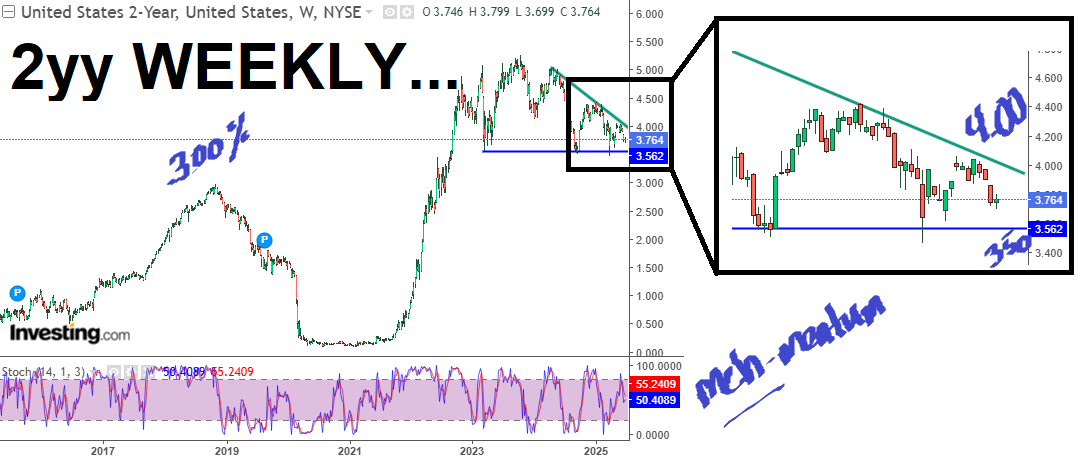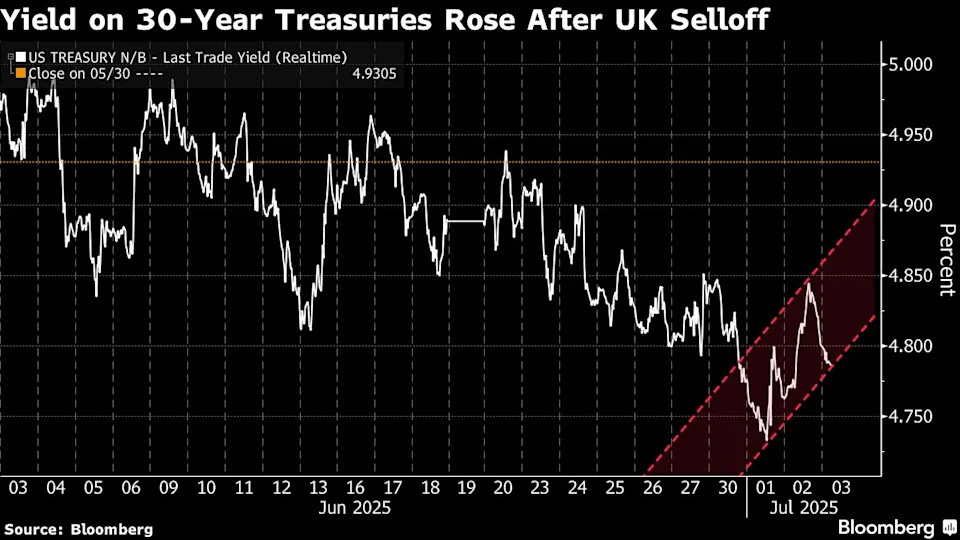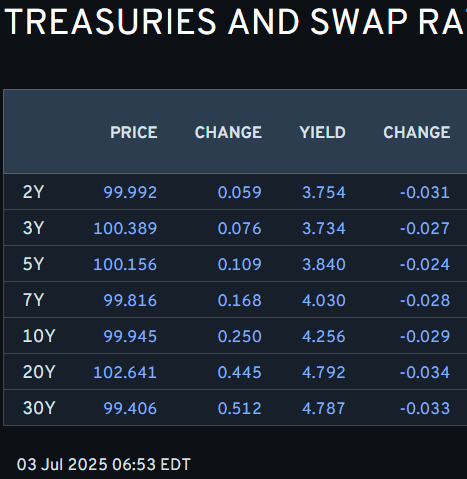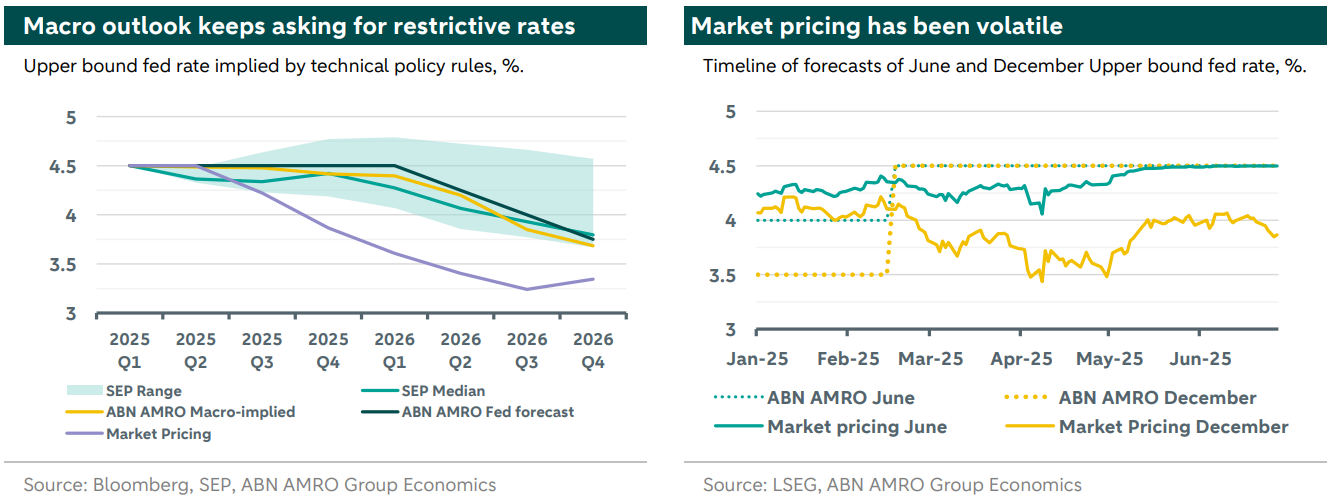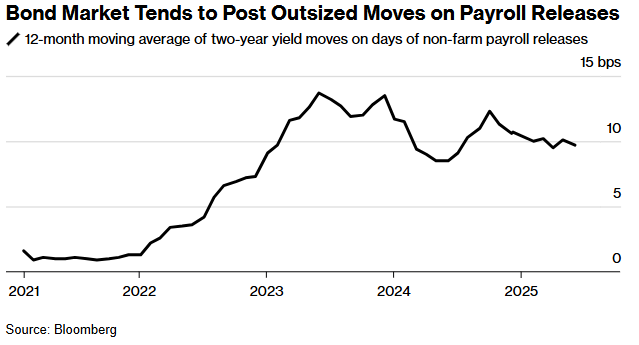while WE slept: USTs firm; NFP precaps followed by victory laps; 12m MA 2yy on NFP days:'outsized moves' on print ...
Good morning … equity futures are little changed, bonds are BID …
I’ll begin with a weekly look at 2s as we head into the next couple hours where I’d fully expect drama to die down by ‘bout 9am as The Hamptons Hedge goes into effect shortly after data prints and Global Wall’s “A” Team heads back to their long weekend (guessing already where they need / wanna be) and leaves staff to manage balance sheet and NOT muck things up …
2yy WEEKLY: 4.00 - 3.50% is broad range extremes to watch …
… as MEH-mentum appears to be in the middle of its range, much like the outright level, itself … meaning there’s little to NO signal to be gleaned from the price action itself (which means we’ve gotta be careful ‘bout those leaning on today’s random number generator to help create any narratives …
… seriously … what is it I could possibly say or slow you down to read / pass along today, here and now.
Moments before NFP … moments after which Global Wall will be DONE, Hampton Hedge in effect, leaving the “B” team (i know, used to be on it) to manage the risk and make sure nothing blows up.
NO risk taking. NO balance sheet at risk. Back those bids up and modify the algo to add a few tics to the offers, too. Widen ALL spreads, just in case…
… whatever.
“A” Team likely already at the beach and may be watching for a few minutes, hoping to catch someone off-guard.
They’ve got far better systems in place than most mere mortals so today, in its entirety, is ‘Amateur Hour’ …
A quick rundown / recap of yesterday’s events …
ZH: ADP Reports Biggest Drop In Service-Provider Jobs Since COVID Lockdown
… that was fun but so, too was, some news from across the pond …
Bloomberg: Long Bonds the World Over Face Intense Trader Scrutiny Once More
…Turmoil in ultra-long bond markets partly reflects worries that governments are spending more than they can afford. The selloff in gilts came days after the UK government was forced to backtrack on welfare cuts. US President Donald Trump’s landmark tax and spending bill, which could pass this week, has fueled concerns about a widening fiscal deficit. Japan’s habit of overspending has for decades been a concern for investors and economists.
…But these fears are being exacerbated by political risks. The gilt selloff came directly after Prime Minister Keir Starmer initially failed to back Reeves when she was questioned in parliament, fueling speculation that her time overseeing the economy may be coming to an end…
ZH: 'Teary' UK Chancellor Reeves Is Safe For Now But The Gilt Market Maybe Not
… and the table is then set for today’s random number generator from which Global Wall will create new and better narratives.
Yea, right … here is a snapshot OF USTs as of 653a:
… for somewhat MORE of the news you might be able to use … a few more curated links for your dining and dancing pleasure …
IGMs Press Picks: July 03 2025
NEWSQUAWK US Market Open: Tentative trade ahead of US Jobs and Bill updates … USTs firmer, but only modestly so, into a frontloaded US agenda headlined by NFP (exp. 110k, prev. 139k). Thus far, the focus has been on the Reconciliation Bill; Rule vote passed, full vote expected in the next few hours, at this stage it should pass without too much issue. USTs in a slim sub-10 tick band, entirely within yesterday's slightly more expansive 111-16+ to 111-30+ parameter.
PiQ Overnight News Roundup: Jul 03, 2025
Yield Hunting Daily Note | July 2, 2025 | Distribution Changes, CEF Allocation, GS Bond
Finviz (for everything else I might have overlooked …)
Moving from some of the news to some of THE VIEWS you might be able to use… here’s some of what Global Wall St is sayin’ …
What to watch AFTER today’s NFP …
2 July 2025
ABN AMRO: Six themes to watch over the summer…US: The Fed’s resistance is crumbling
Fed governers’ claims to be able to ease by July are likely politically motivated
Still, with pressure mounting, FOMC members increasingly signal openness to a September cut
The risk of easing too soon remains, with little sign of inflation, while economic slowdown visible.
President Trump is not happy with the Fed keeping rates on hold ever since he’s been in office. Still, his administration’s policies are the primary reason the Fed is hesitant to further ease rates. While recent data suggests the Fed could consider lowering rates, Chair Powell made it clear in his press conference that the uncertainty around the economic outlook, particularly the impact of tariffs, is the primary reason they remain in wait-and-see mode. Removing Powell from office remains unlikely, but Trump recently revived the idea of a Shadow Chair, with Bessent suggesting to appoint the successor to the Fed board spot that opens up in January, rather than explicitly as chair in May of 2026.
Since the June meeting, more FOMC members have revealed their views on the policy path. The most striking statements come from Christopher Waller and Michelle Bowman, who both called for a rate cut as early as this month. We think these statements are largely political. Waller is a fringe contender for the chair position and Bowman has been named vice-chair by the President. These statements are dangerous nonetheless, playing into the White House narrative at a time when the attack on Fed independence calls for a united front. Other members have been milder, expressing the need for more data to gain confidence that tariffs won’t raise inflation in a persistent way. Some state that their base case is that this will lead to a September cut, while others say it could lead to a cut as early as September but are less committed. Powell himself moved from awaiting data ‘over the next year’ to data in ‘June, July and August,’ for rate decisions.
The summer will be instrumental. By the July meeting there will be a single extra CPI report, and possibly clarity on the pause on the liberation day package, which officially expires on 9 July. What rate path would be reasonable given the outlook? Using a set of technical policy rules – by no means a definitive reaction function – we generate policy responses to the forecasts of inflation and unemployment in the latest Summary of Economic Projections (SEP). We take the median and a range based on the most hawkish (highest inflation, lowest unemployment) and most dovish response (lowest inflation, highest unemployment). The median forecast implies a single cut could happen this year, with another two in 2026. The range shows this single cut is the most supported by the current outlook, with the most hawkish scenario even calling for a rate hike. More rate cuts would require a drastic change in expectations on tariff-induced inflation. Our own forecasts imply a slightly more hawkish path than the median SEP, with our actual Fed forecast again marginally more hawkish on the back of the risk of inflation expectations de-anchoring.
Current market pricing is far outside the range implied by the SEP, and we’ve argued before that it is unrealistically dovish. The conclusion that it seems to assume a significant deterioration in the labour market without inflationary pressures still holds. The chart on the right shows market pricing for the fed funds rate on June and December 2025, along with our view. Following various tariff announcements, we shifted from a dovish to a hawkish view in February, with no more rate cuts. For June, this ultimately proved right. For December, market pricing has since diverged but also come back a bit again. Two rate cuts can be priced in or out in the span of a week. We continue to expect no rate cuts this year, but we judge the risk to our projected path errs on the side of more easing. Not on the back of less inflationary pressure (see also the lead article), but rather on signs of a slowdown that is broadening, with e.g. personal spending falling even without tariffs boosting prices, and a slowly deteriorating labour market. Alternatively, the Fed might ease because of financial stability considerations in response to a variety of potential triggers, such as the passing of the Big Beautiful Bill, possibly combined with the trillions of T-Bill issuance around the same time.
Best in biz with a recap of ADP and closing commentary …
July 2, 2025
BMO: ADP -33k June (Second Negative Print Since Pandemic)… This is the first negative print since March 2023, and second negative print since the early stages of the pandemic … ADP Chief Economist Nela Richardson said, "Though layoffs continue to be rare, a hesitancy to hire and a reluctance to replace departing workers led to job losses last month... Still, the slowdown in hiring has yet to disrupt pay growth." Overall, it was a disappointing jobs proxy that sets up tomorrow's BLS release as a major wildcard …
July 2, 2025
BMO Close: The Uncertainty of NFP… The most enduring trend on Wednesday was the curve steepener. The front end of the market remains well anchored with 2-year yields near 3.75% while duration underperformed in a move that was already underway ahead of the negative ADP print. The bid for 2-year notes resonates when one views the ADP update in the context of Powell’s less hawkish tone earlier in the week. While the Chair continued to emphasize the Fed’s wait-and-see stance, the market has interpreted Powell’s unwillingness to directly push back against a potential July cut as implying a more flexible policy skew. Of course, the Fed is in data-dependent mode and if there is unexpected weakness on the labor front, then Powell will need to address the employment component of the Fed’s dual mandate. Taken in isolation – the tone shift and ADP figures wouldn’t be particularly troubling for tomorrow’s outlook. However, when combined with the highest NFP-survey week print for initial jobless claims since the summer of 2023, a more cautious approach to Thursday’s dataset is warranted.
The holiday-shortened week has condensed the data release schedule with the trade deficit and jobless claims figures now being released alongside NFP. However, it all comes down to payrolls and the unemployment rate. The earlyJune scenario remains fresh in the minds of the market. Recall that the Treasury market rallied into the BLS release in anticipation of a disappointing print only to selloff sharply on what was effectively a consensus print. We’re wary of the same setup that will raise the bar for the magnitude of any downside to push yields lower. In this context, the fact that 10-year yields remain above 4.25% and have bounced off the 4.185% low implies a reasonable amount of balance and provides the market enough of a range to react to the data without pressing yields into new territory….
German bank stratEgerist weighs in on UK situation and these comments regarding USofA caught my attention …
3 July 2025
DB: Early Morning Reid…Whilst the UK was dominating attention, it wasn’t all bad news yesterday, and the S&P 500 (+0.47%) climbed to a new record as hopes mounted about potential trade deals. The main catalyst was Trump’s announcement of a deal with Vietnam, which he said would see them pay a 20% tariff on goods exported to the US, whilst the US would pay a zero tariff on their own exports. So that raised hopes about further announcements before the July 9 reciprocal tariff deadline next week. And some of the more trade-sensitive sectors did particularly well, with the Philadelphia Semiconductor index up +1.88% on the day and the S&P 500 Autos subsector was up +4.64%.
Looking forward, attention will remain on the US today, as the jobs report for June is coming out later on. This month it’s on a Thursday because of the Independence Day holiday tomorrow, and our US economists at DB expect nonfarm payrolls to come in at +100k. That’s a bit slower than recent months, with the 3-month average currently at +135k, but they point to higher initial jobless claims in the survey week, and a pattern of subdued summer payroll gains over the last couple of years. In turn, they think the unemployment rate will rise to 4.3%, although the risk is that it could round down…
… as did global markets survey …
3 July 2025
DB: Summer 2025 Global Markets Survey ResultsHere are the results of our latest global markets survey with 420 responses between 30th of June and 2nd of July 2025.
Some high level views:
Responses suggest that only 1% believe tariffs after July 9th will be as widespread as levels first imposed on Liberation Day.
Only 7% believe that the era of US exceptionalism is coming to an end more rapidly but in total around half think the era is coming to an end in some form.
When we look at the US fiscal deficit, 12% expect it to be a major market influence in the next year, however this changes drastically for 5 year horizon when over half think it will be a significant market driver.
Just 16% are confident that the Fed is completely independent.
The EUR is the preferred currency for 78% in the next year, but over the next 5 years, it’s roughly a 50-50 split versus the USD.
The percentage of those who have not used AI for work-related tasks has halved in the last year, falling from 48% to only 24%.
… a question …
2 July 2025
ING Rates Spark: Can payrolls hang in there?Payrolls day remains the most important one for markets. Even going into most pivotal Fed meetings we typically know what's going to happen. For payrolls, we think we know. And even if we did, the print itself can have a perverse effect. The big fear is we get a really bad one sometime soon. Feeling bullish? Fair. But, weak payrolls also means a higher deficit
An idea into NFP — will either be champ or chump at 831a …
July 2, 2025
MS US Rates Strategy: Maintain 2s10s CPI Swap SteepenersCPI fixings markets point to a low CPI print for June, and our breakevens tactical trading model indicates that 10-year breakevens can widen from here, leading to further steepening in 2s10s CPI swaps. Upcoming payrolls print has asymmetric risk-reward toward steepeners.
Key takeaways
CPI fixings are currently pricing in 29bp M/M headline and 26bp M/M for core inflation for the upcoming June print
Mean reversion in 2-year and 10-year iota spreads has aided in further steepening of the curve
10y breakevens have scope to widen from here based on signals from Financial Conditions Index, equities, and beta-weighted breakevens
Our public policy team has a baseline expectation that the administration will seek to roll forward the July 9 deadline regarding tariffs
And ahead of today’s data, an idea that may / may NOT hinge on payrolls outcome. A preca[ and ideas … In other words, either gonna be a champ OR a chump …
2 Jul 2025
NatWEST US: Employment Preview (June)We expect payrolls to continue to decelerate gradually in the coming months, but we don’t anticipate any major changes in the trend in June. We estimate an increase of 105,000, with private payrolls rising by 110,000. For the first five months of this year, monthly average job growth was 124,000, with private payrolls up by 117,000 over that time frame; that compares with overall payrolls up an average 168,000 in 2024 and private payrolls up 130,000 per month. Our headline estimate is modestly below the Bloomberg consensus of 110,000, with the range of estimates between 70,000 and 160,000, while our private payroll estimate is modestly higher than the consensus (currently 102,000 versus our 110,000 private forecast) …
2 Jul 2025
NatWEST: Bullish US front end rates as dovish risks increaseSummary
We think there is value in positioning for bullish front end moves in the SOFR complex in the vol space as risks increase of the next Fed Chair being more dovish and of further labour market softening, seen through employment growth being revised downwards and a miss in the June ADP payrolls.We propose three structures below, each with different day one profiles, but similar upfront costs and terminal PVBP. The seagull offers the most attractive terminal payout, as it benefits from being short vol and thus positive carry.
Given the strong downwards moves in vols since tariff reliefs were announced in mid-April, we would be cautious to use structures that rely heavily on volatility selling (such as ladders or seagulls), as the best expression of a bullish rate view at this point in time. We lean towards structures (such as receiver flies or spreads) that spend premium and reduce daily mark-to-market concerns, focussing instead on terminal value and directional conviction.
Hints of weakness in the air …
03 Jul 2025
UBS: Hints of labor market weakness?Tomorrow’s US holiday means US labor market data appears today. There is a hint today’s report may be weak. US presidents normally see the data the night before release. Last night, US President Trump issued a social media post calling for Federal Reserve Chair Powell to resign. Policy uncertainty and the largest tax increase in modern times are more likely to damage the labor market than Fed policy, but the post might signal weaker data.
After three months, the US agreed to Vietnam’s offer of 0% taxes on US imports. The US intends to tax US consumers 20% for buying Vietnamese goods, with 40% for goods passing through Vietnam (relevant for China, which rerouted about 30% of US-bound exports in Trump’s first term). Trump suggested Vietnam might like to buy US SUVs. In 2023, the average Vietnamese employee earned around USD 3,500 per year.
US May trade data is due. Some US imports will be tariff free. Goods already en route to the US on 4 April were not subject to tax on arrival. Given travel times from Asia and Europe, a proportion of May imports will be tariff-free…
… finally, Dr BOND Vigilante weighs in and agrees WITH … bonds …
Jul 2, 2025
Yardeni: Bond Yield Rises, Ignoring Weak ADP Payrolls ReportThe 10-year Treasury bond yield rose yesterday and today on mostly upbeat employment indicators. Yesterday, the JOLTS report came in stronger than expected. In addition, initial unemployment claims edged down, according to yesterday's report. Today, the Challenger report showed a drop in layoffs. The bond market chose to tune out the uptick in continuing unemployment claims in yesterday's report, and it also ignored today's weaker-than-expected ADP payroll report.
We are inclined to agree with the bond market's current assessment: The labor market remains relative strong. The bond market clearly won't ignore tomorrow's employment report, especially if it is surprisingly weak. If it is weak, though, we doubt that it would change our minds because we view the current slowdown in economic activity as just a first-half-2025 soft patch. We still expect that the tariff issue and geopolitical worries will weigh much less on the economy during the second half of this year. The record highs in stock prices confirm our outlook and also increase its probability of panning out, by providing a very positive wealth effect on consumer spending. Low gasoline prices provide another tailwind for consumer spending.
Our guess is that June's payroll employment rose between 100,000 to 125,000…
… And from the Global Wall Street inbox TO the intertubes, a few curated links …
Perhaps stating of the obvious, but a reminder …
July 3, 2025 at 2:00 AM UTC
Bloomberg: Bond Traders Eye High-Stakes US Jobs Report for Fed Rate Clues… “A weak print would certainly make July a live meeting, while a strong report would take a July cut off the table completely,” said Dan Carter, portfolio manager at Fort Washington Investment Advisors.
Treasuries have rallied in recent weeks on expectations that a softening labor market will give policymakers the data they need to start bringing rates down. Traders have priced in more than two quarter-point cuts this year, with the first move in September, but also about a 25% chance of an earlier cut at the July 29-30 meeting.
In recent weeks, bond traders have been ramping-up long positioning in Treasuries, supporting a move lower in yields. The 10-year benchmark has dropped to under 4.3% from around 4.6% in May…
… and from RenMac’s Dutta …
July 2, 2025 (via LinkedIN)
RenMac: I've been surprised by the stock market's strength.Stock prices continue to rise even as economic data surprises have been negative, on net. Take a look at the nearby figure, which plots Bloomberg's US Data Surprise Index against the S&P 500. Yes, I know technology stocks have been a huge source of support for US equities, but even equal-weight is doing well.
So, what gives? I think the easiest way to read this is that stocks anticipated some pain in the economic data following the Liberation Day announcement and heightened trade tensions. With trade tensions being dialed down, stocks are looking ahead to a stronger second half.
The risk with this sanguine base-case is that the slowing in the economy was not really about trade tensions to begin with.
Will organize something over the weekend with any NFP victory laps and I’m taking a day — Monday (Thing 3 has a 7 on 7 as football starting to gear up) so undetermined IF I’ll be spamming Monday but first … sorry, not sorry … the original BREXIT ….
… THAT is all for now. Off to the day job…


